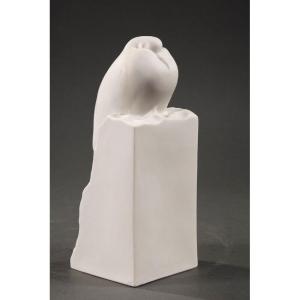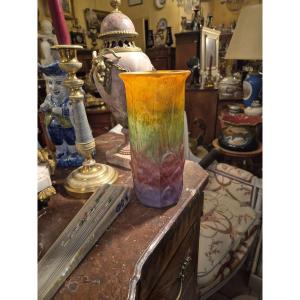model 27
Cameo glass
France
Model created in 1912 and distributed until 1917
18 works made
height 11.6 cm
A similar model is represented in "François Décorchemont, Maître de la pâte de verre", Véronique Ayroles, Editions Norma, 2006, pp. 66 and 235.
our web catalog link :
https://galerietourbillon.com/decorchemont-francois-coupe-entonnoir-modele-27/
Galerie Tourbillon : Free valuation - Buy and Sell at best prices
Biography:
François Émile Décorchemont (1880-1971) was a French ceramist and glassmaker. Coming from a family of artists, he studied at the National School of Decorative Arts in Paris, and then made many cameo glass objects that bring him notoriety. Décorchemont invented then a new material, the crystal paste. In the spring of 1912, François Décorchemont presented for the first time at the Salon des Artistes Décorateurs, then at the Salon des Artistes Français, a set of pieces that testified to a new path taken by the artist. The thick and translucent walls, powerful and luminous, of these creations contrasted with the extreme finesse and opacity of the models that, since 1903, date from his beginnings, characterized his glass works.
From 1909, while maintaining his production of fine cameo glass, François Décorchemont was engaged in the experimentation of a new molding technique. With the help of his father, Louis-Emile Décorchemont (1851-1920), a sculptor, collaborator of Jean-Léon Gérôme and professor of sculpture at the National School of Decorative Arts in Paris, he undertook to adapt the process of lost wax casting to glass. At the same time, he was experimenting with a new vitrified paste composition ensuring transparency and light. Of a sensitivity close to the works of Albert Dammouse, the creations of Décorchemont were distinguished however by the refusal of the molding on nature of the natural elements and by a desire for sculptural effects emphasizing the forms and the constructive lines of his decors. This new conception of ornament and this quest for a thick and translucent material, from a perspective that was not only decorative but also constructive, was in line with contemporary research by René Lalique, whose technical advances during the 1910s were part of the same desire for aesthetic renewal.
As a fervent Catholic, it was while attending the church of his village, ornated with windows of the Renaissance, that in the 1930s, it came to him the idea to apply his technique to the art of stained glass. François Décorchemont then developed a unique technique to design stained glass windows not in painted glass but in colored cameo glass in the mass. His new activity began with the construction of the church Sainte-Odile in Paris for which he realized the 300 m2 of windows. At the end of the war, he worked mainly in the Eure, where he posed no less than 130 stained glass windows in thirty churches, including the remarkable ensembles of Beuzeville, Etrépagny or Ménesqueville. François Décorchemont also intervened at the Saint-Wandrille Abbey in Saint-Wandrille-Rançon (Seine-Maritime), at the former convent of Folie Couvrechef in Caen and at the parish church of Fontaine-Henri (Calvados).
Very discreet and not communicating, François Décorchemont kept secret his discoveries and his techniques. Painter, ceramist, glassmaker, he created all his works, drawing, mold, finishing. His work was characterized by a clean design, simple lines and brightness, transparency and brightness of colors. His creations had no functional value but only aesthetic because of their fragility and their cost of production. He edited his works in small series and did not seek performance but aesthetics.





































 Le Magazine de PROANTIC
Le Magazine de PROANTIC TRÉSORS Magazine
TRÉSORS Magazine Rivista Artiquariato
Rivista Artiquariato